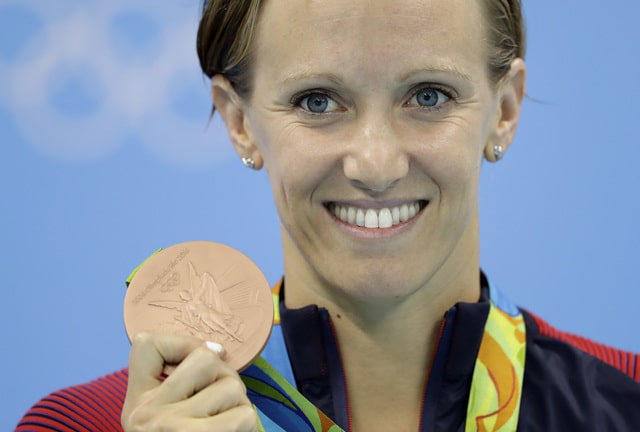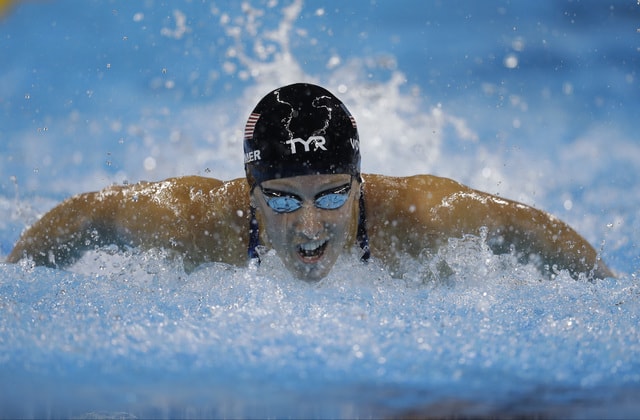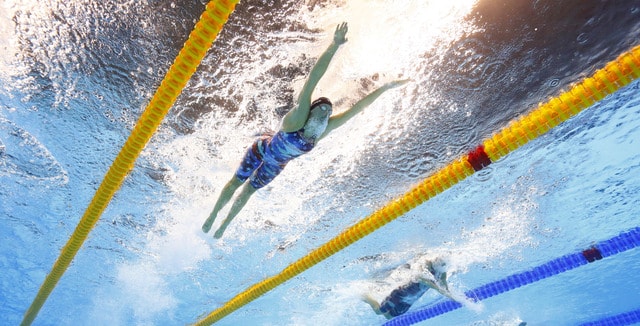


RIO DE JANEIRO (AP) — If you strapped weights to Usain Bolt’s chest, replaced his six-pack stomach with abs stretched out of shape, de-tuned his muscular frame and explosive power by jellifying his joints, and forced him to take the best part of nine months off, how amazed would we all be if the world’s fastest man fully recovered from that fitness-shredding assault to once again vie for medals at the Olympic Games?
Short answer: stunned. Likely adoring.
Yet, across the Rio Games, amazing women are doing exactly this without the celebrate-this-from-rooftops full fanfare they deserve.
We’re talking, of course, about Olympic moms.
By competing post-pregnancy, the likes of self-declared “Momma on a Mission” Dana Vollmer, a swimmer, are showing that having children and a continuing career in elite sport need not be mutually exclusive. That freedom to not have to choose either one or the other is important in encouraging women to compete for longer and later into their lives.
On the most fundamental level, if nationalism and the race for medals are stripped away, the Olympics showcase what an astounding piece of machinery the human body is: malleable, adaptable, capable of absorbing and recovering from great punishment.
Olympians who have put their bodies through motherhood and then willed and beaten them back into world-conquering shape are the purest embodiment of this.
They are also something of a scientific mystery.
Kari Bo, a Norwegian School of Sport Sciences researcher working on IOC-backed studies in this field, notes big holes in the scientific community’s understanding of how pregnancy affects elite athletes’ bodies. One common yet not fully understood impact is on joints.
In pregnancy, the body produces a hormone, relaxin, that helps loosen up ligaments and the pelvic area for birth.
Once back in the Olympic business of aiming faster, higher and stronger, looser joints aren’t necessarily a plus.
British 10,000-meter runner Jo Pavey, competing at her fifth Olympics, blames relaxin for collapsing the arch of her left foot during pregnancy. She had to wear a bigger shoe on her left foot than on her right and stress-fractured her big toe, with a diagonal crack through a bone.
Vollmer, who has an individual bronze and relay silver so far in Rio, says looser ligaments were “a big thing for me” in her post-pregnancy comeback. Having battled injuries in the past, she worried about over-extending her newly more flexible joints.
“I played it really cautious,” she says. “Just trying to make sure that everything was really stable before I really cranked on my strokes.”
And what of her post-pregnancy abs, so vital in her stroke, the butterfly?
“There were none,” she says matter of factly.
After seven weeks of enforced bed rest and having gained 50 pounds (22 kilograms), the triple gold medalist at the 2012 London Games was “probably 10 percent” of the athlete she used to be when she started working out again following her son Arlen’s birth in March 2015, says her coach, Teri McKeever.
Gains and shifts in weight from pregnancy and breastfeeding also disrupt balance and change “your relationship with the water,” McKeever says.
“She still had a nice stroke but you go 100 meters and you have to stop,” the coach says. “It’s amazing how quickly you lose it.”
Defending Olympic heptathlon champion Jessica Ennis-Hill also became a mother between London and Rio. To stop her from comparing herself to the athlete she was before son Reggie’s birth in July 2014, her coach, Toni Minichiello, wiped the slate clean, using what he calls “post-pregnancy personal bests” to measure Ennis-Hill’s progress since.
“Physically she wasn’t the same person,” Minichiello says on a blog chronicling their Rio journey. “It was really tough mentally. Her body was changing month to month.”
Weakened ankles were a post-pregnancy problem for U.S. high jumper Chaunte Lowe, competing at her fourth games, because “I had been waddling for so many months.”
“It felt like it was impossible,” she says of resuming jumping. “You have that question of whether you have lost it forever.”
Second and third pregnancies broadened out what had been slim, boyish hips, giving Lowe less ideal new curves to squeeze over the high bar.
“By the third time, I felt like I had it down,” she says. “But then I was sleep deprived.”
So why start a column about amazing women with an amazing man, Bolt?
Because if men were capable of all this, you can be sure more fuss would be made.
There’s a school of thought which holds that it demeans women to make a big deal of pregnancy. After all, the argument goes, women have babies all the time.
But few of them, too few, come back to compete at the Olympics. Just 10 of the 298 U.S. women are also moms.
“I was told that you can never get your body back,” Vollmer says. “I wanted to show that you can. I think it will keep women in sports much longer, that you can have family and you can make it work.”
They deserve our applause.




